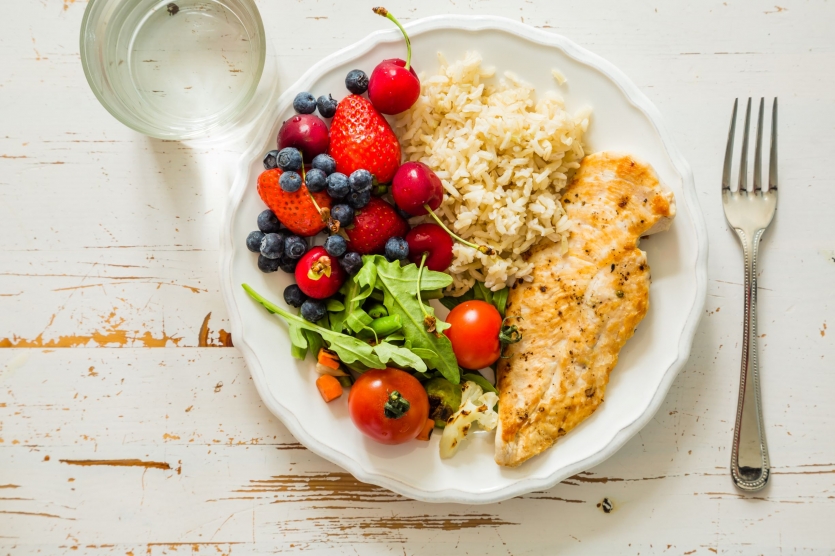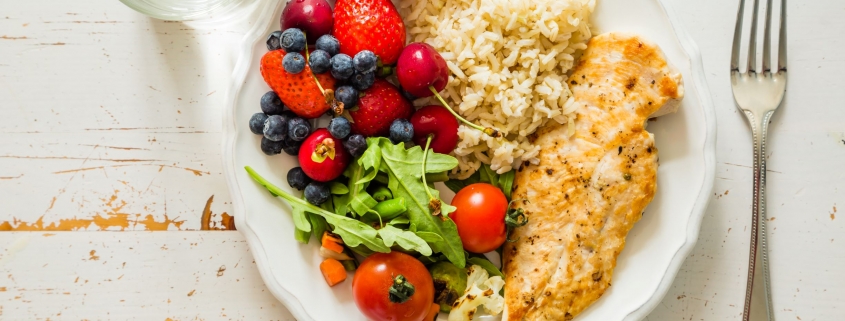Eat Less, Enjoy More | A Portion Control Guide

You and a few friends sit down at your favorite restaurant, order appetizers and a meal, and enjoy each other’s company as you fill up on patatas bravas. Without realizing it, you’ve polish off your plate, sans any portion control whatsoever—over 1,200 calories consumed in half an hour, more if it was washed down with a soda.
Everyone’s been there, stewing in lack of self-control guilt after overeating. But cut yourself some slack—cultural shifts are some the biggest consumption culprits. Restaurant servings sizes have doubled, even tripled, over the last 25 years. This is contributing to a crushing calorie overload and soaring obesity rates.
A fast-food burger ordered in the early ‘90s would’ve weighed in around 4.5 ounces (about 128 grams). Today, that same burger sits at 8 oz. (about 227 grams). In turn, plates at home have become fuller to match the new norm. Preservative-packed prepackaged foods have also steadily become staples, replacing home-cooked meals.
The world is seeing steady increases in average calorie consumption. But you can reverse the trend in your own life with easy, effective planning. Savor your meals, without the guilt, using portion control science.
Weighing the Portion Control Benefits
Why is portion control important? It helps you manage overall caloric intake while ensuring you feed your body the right types of macro and micronutrients. Whether you have a weight-loss goal, want to adjust your BMI, or aspire to maintain a healthy weight, your body will appreciate the beneficial nutrients you may otherwise miss. Your wallet will thank you, too, since every ingredient will go further. And you can say goodbye to mindless munching straight from the package.
The importance of portion control extends to your gut. Too-large portions may cause indigestion and discomfort. If you feel cramped or bloated after a big meal, overeating could be to blame. Measuring out meals will leave you feeling refreshed, content, and energized after eating—defeating the dreaded “post-lunch brain fog” once and for all.
Beyond belly imbalance, a calorie surplus (consuming more calories than your body can burn) has been shown to contribute to overall weight gain, even in active adults and athletes. With the exception of pure protein, overfeeding tends to have a negative effect on body composition, resulting in increased body weight or fat mass.
Eating for Your Body Type and Activity Level
Making portion control science work looks a bit different from person to person. Your genetics and lifestyle play a major part in the amounts and types of nutrients you should eat. Start by determining your body type—endomorph, ectomorph, or mesomorph. This will help define your macronutrient ratio—protein, fat, and carbohydrates—and whether you should err on the side of more or fewer calories on an average day.
Know Your Nutrients
The more you know about nutrients, the easier it is to design a diet that fits your needs and goals. Learn more about macro and micronutrients today.
The next step is inputting your height, weight, and a few other stats into a Basal Metabolic Rate (BMR) calculator. BMR calculators offer a rough estimate of the energy your body currently expends in a neutral environment (like binge-watching an entire season of your favorite TV show). Factor in your activity level and add in any of your energy-burning hobbies. Here are a few common activities measured out in 30-minute increments by Harvard Health Publishing for a 155-pound person:
- 112 calories for general weightlifting
- 130 calories for golf (with a cart)
- 167 calories for walking at a 3.5 mph average
- 223 calories using a stair-stepper
- 260 calories for low-impact aerobics
- 298 calories for general circuit training
Combine your BMR, general activity level, and all the motions you make to determine the average number of calories you should aim to consume in a day.
Master Your Meal Plan
You’ve done the math. Now it’s time for the exciting part: making your own personalized portion control guide. Determine the nutritional content of your favorite foods and ingredients, and read the nutrition facts label found on packaged goods. Pay special attention to the serving size—it will surprise you how microscopic the recommended portions can be on many processed foods. For home cooking, a kitchen scale could be a new staple for fast, accurate ingredient measurements.
While your body type will guide you towards the right type of diet, you can’t go wrong with the “golden ratio” of macronutrients. On average, half your plate should be vegetables, a quarter of protein, a quarter of complex carbohydrates, and a dash of healthy fats. Eating within these parameters ensures plenty of satisfying fiber and a range of phytonutrients and other micronutrients that simply aren’t available in a take-n’-bake pizza. Plus, veggies tend to be lower in calories compared to protein-rich foods, while healthy fats tend to be calorie-dense. This means your meals will still be hearty, even when measuring out portions.
The right ratios don’t have to be boring. In fact, eating a varied diet contributes to gut diversity and is a predicator for a healthier heart and weight range. Challenge yourself to try fruits and vegetables from every color of the rainbow and you’ll enjoy great flavors and beneficial compounds in no time.
The Practice of Portion Control
The importance of portion control becomes less meaningful when it isn’t practiced consistently. Make perfectly measured meals a habit with these tips:
Portion Control Tips
- Use smaller plates. It’s the simplest, and most effective, method of portion control. Studies show people eat less—or more—depending on their dishware dimensions, regardless of how hungry they were to start.
- Meal prep during the week. Measuring, cooking, and storing a week’s worth of meals ultimately saves time, allows you to eat on the go, and ensures you stay on track—even on your busiest days.
- Give yourself a hand. When a scale isn’t available, your hand makes for a solid portion control guide. Protein portions should be about the size of your palm, carbs sized to a clenched fist, and fats portioned to the size of your thumb.
- Drink a tall glass of water before each meal to help trigger your stomach to signal fullness. Actually, you should aim to stay hydrated all the time—a win-win for your overall health and portion-control goals.
- Eat purposefully. It can take 20 minutes or longer for your stomach to signal feelings of fullness to your brain. Take your time with each bite, appreciating the textures and flavors. And put down the smartphone at the dinner table to avoid the risk of distracted overeating. (And because it’s rude, of course.)
- Enjoy healthy, whole-food snacks like almonds, apples, or celery sticks with hummus dip between meals. Utilize the glycemic index to shop for low-glycemic foods—a satisfying way to silence tummy rumbles.
- Split the meal when eating out, or ask for a half serving. Even if you tell yourself to be extra-vigilant as you order, it’s too easy to overdo it with often-exaggerated portions. At the very least, secure a to-go box at the same time as your food is delivered and divide out your leftovers. Peruse the menu for lighter fare or lunch options—they offer healthier choices and classic meals in smaller portions.
- Make less mean more. Intermittent fasting is a popular eating option that simplifies eating by condensing your caloric intake into fewer meals. It’s also shown to decrease fat and maintain energy levels.
- Keep a journal. Jotting down what and how much you eat every day, as well as including brief notes on your daily reactions, can help paint a picture of how nutrition affects your life. Look for trends, and bring up your thoughts with a trusted nutritionist.
- Ensure enough quality sleep to help regulate hormones associated with hunger. A multitude of other physical and mental health benefits surround a sound night’s slumber.
- Remove the temptation. Your environment strongly influences your behavior. You know yourself better than anyone, so address your weaknesses. If you often reach for a cola at 3:00 p.m., go for a walk at 2:55 p.m. instead.
Your hand makes for a perfect portion control guide.
Experience the Importance of Portion Control
Society may be eating more than ever before, but armed with the know-how—along with a little practice—you can reign in your dietary habits. You’ll save money, nourish your body with the right nutrients, and lose the overeating guilt. And the next time you visit your favorite go-to restaurant, drink a tall glass of water, portion out a to-go box, and enjoy every bite.
With the right mindset, it’s easy to make portion control science work for you.
References
https://www.nhlbi.nih.gov/health/educational/wecan/news-events/matte1.htm
https://academic.oup.com/ajcn/article/107/4/640/4964655
https://www.ncbi.nlm.nih.gov/pmc/articles/PMC5786199/
https://www.tandfonline.com/doi/full/10.1080/17461391.2011.643923
https://www.sciencedaily.com/releases/2018/01/180125135523.htm
https://pubmed.ncbi.nlm.nih.gov/15761167/













